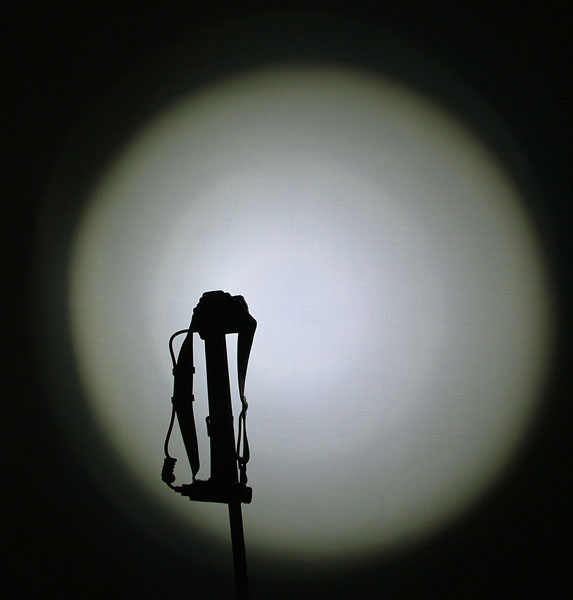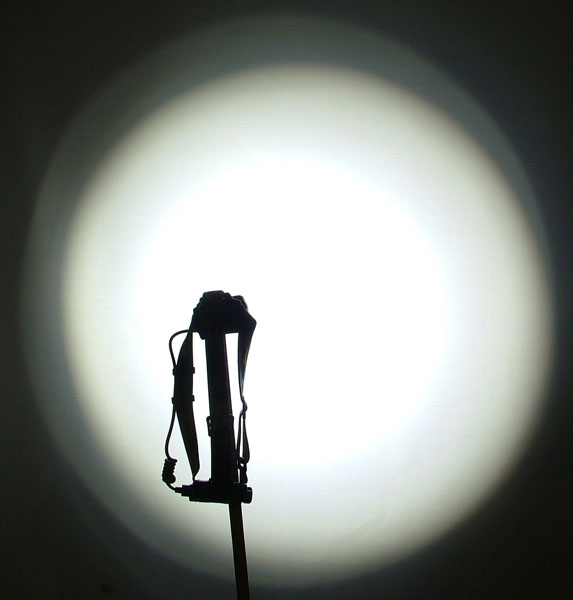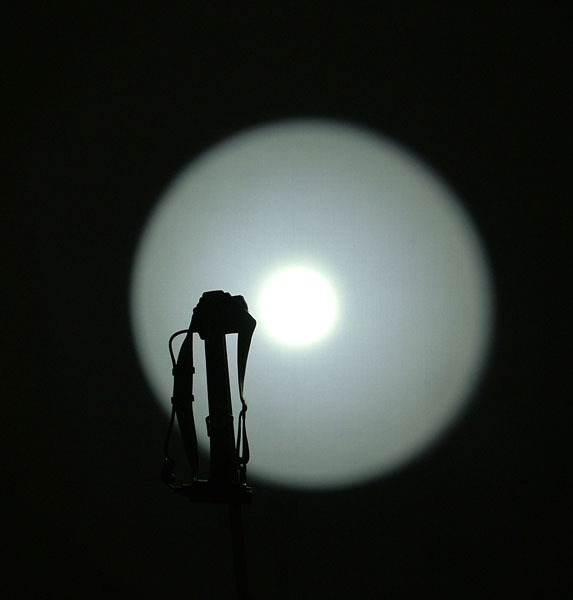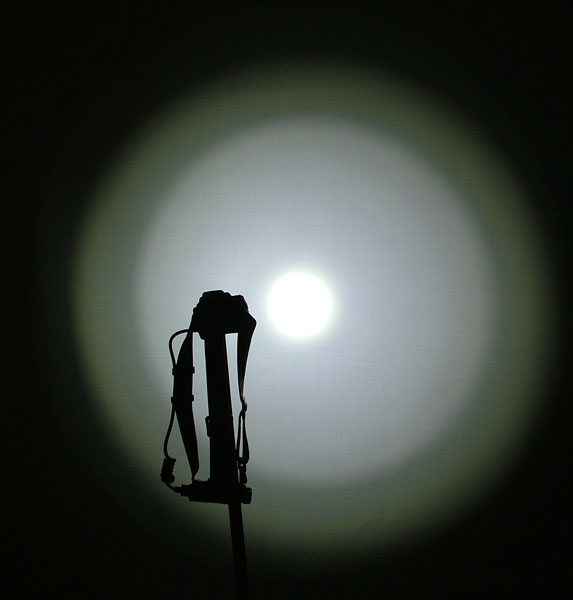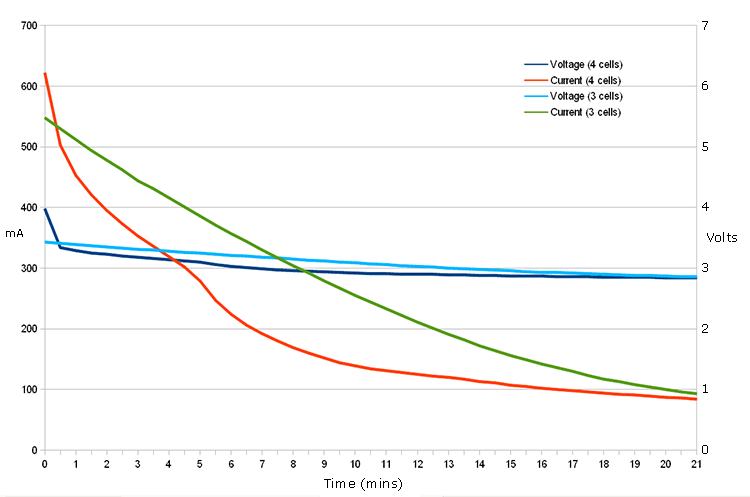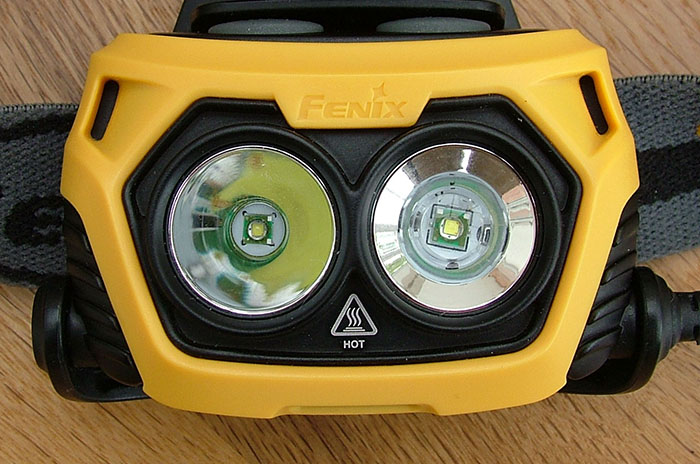uk_caver
Flashlight Enthusiast
Possibly I should start by saying I have been using twin-beam headlamps for a long time (over 9 years), both for caving and surface use, and I have developed some definite preferences, but, I think, not unreasonable ones.
Also, to save myself from using the wrong terms, I'm going to avoid talking about low/med/high/turbo, since for some as-yet-unexplained reason for this light they mean different things for the two beams.
Operation is simple, with one pushbutton per LED, and using brief presses of the appropriate button to cycle indefinitely through the power levels, longer presses for off/on, and an extended press to engage SOS on the spot beam. Button pressure is a decent ~1kg
I do like having indefinite sequences with turn-off needing a more deliberate long action, though the need to hold a button down to turn on did seem a bit unintuitive.
Since the buttons are covered by a shield when the head unit is rotated back into its bracket, the long press to turn on doesn't seem necessary to prevent accidental activation, but I suppose most users will adjust to it in time.
The headstraps attach fairly easily, though they do take a little bit of manoeuvring under the split bars on the battery box.
The battery box itself looks reasonable, with gold-plated springs and contacts, though I haven't given it any immersion testing.
The user instruction sheet suggests the O-ring on the removable part is replaceable if it eventually wears out or gets damaged, but looking at it, I'm not sure how easy that would be. That said, given that all the contacts are accessible on the slide-out battery holder, they should be fairly easy to clean if dirty or to pre-emptively lubricate if the box was eventually found to leak.
Now, onto the beams.
I'm afraid beamshots will have to wait, but I will post some in the post below this one when they are done. To be honest, I'm not sure how useful they would be - white wall shots might emphasise things which are rather less obvious in actual use, while in-use shots showing significant things like transitions between beam areas might be tricky.
The flood beam is slightly centre-weighted, and does have some minor artifacts.
Looking at a white wall, it is, to a first approximation a couple of concentric circles, with the inner circle being about 3/5 the size of the outer one, and slightly brighter, though not hugely so.
The outer circle has a fairly hard cutoff, though on my unit there is also a slightly off-centre halo of much dimmer light outside the outer circle, shifted towards top left (on bottom right, the halo edge touches the main beam edge).
Rough luxmeter results might give some perspective in terms of variation across the beam.
I made some readings with the light and meter kept at constant distance, set up so that the beam centre gave a reading of 100, with the light being rotated to measure output in various parts of the beam.
In my light, with the beam centre at 100, the output across the inner circle varied between 95 and 110, tending to be slightly brighter towards the edge, so is effectively flat. In the outer circle it was mainly around 60-70, so not drastically darker.
I suppose the acid test for flood smoothness for me is reading, and I found reading with the HP25 absolutely great - I didn't notice any unevenness at all in the area of the beam I use to read, and even further out I had to look and know what I was looking for to really see anything.
In outdoor use, even walking along a fairly uniform-coloured road and actively looking for issues, the inner/outer circle boundary only seemed to be a rather faint slightly brighter line, so essentially flawless.
The faint halo outside the main edge of the flood which was visible on a white wall was not obvious, but on my light it was most present at the top and left of the beam where much of the time there is little to be lit, and a fair amount of it overlapped the area where the rims of my glasses interrupt vision, so wasn't really somewhere I was looking anyway.
The overall width of the flood was OK, with walking typically using the headset tilted down two or three clicks to properly light the area about to be stepped on with the head at a natural angle.
It's a distinctly tighter beam than my original Zebralight, and I'm not sure I'd want it to be any tighter, but than having it just-wide-enough does give advantages in terms of intensity.
The spot beam is quite tight, with an even circular hotspot and a much dimmer local halo visible on a white wall, but at realistic distances outside, the spot just seems to have a somewhat softened edge and no obvious halo.
There is a fairly even low spill extending out to a sharp cutoff at a circular edge only a little outside the edge of the flood beam's inner circle.
Outside the centre, the spill intensity is something like 1% of the central intensity, which may not sound like much, but it still measures as brighter than the flood beam when the flood is running at half the power output.
Outdoors, the spot does light distant objects well, though if looking at distant objects, the edge of the spill on the ground can still seem quite bright.
In a twin-beam light it's arguably unlikely that someone would be using the spot beam alone for non-spot duties like walking, but apart from the spill area being slightly narrow and hard-edged, the spot is quite usable for general movement.
As beams to use individually, I think both are decent, but I'm not sure they're the perfect ones to run simultaneously. In particular, the reflectored spot beam with a naturally hard edge to the spill is maybe not ideal for mixing with a flood since the edge of the spot's spill does give a significant two-level nature to the combined flood at most flood/spot blends. A spot which had less spill and particularly a softer outer edge to the spill could be blended rather more easily.
One of my long-time personal favourite beam blends is flood-plus-a-touch-of-spot, with the spot helping to significantly increase the reach of the flood without consuming meaningful extra power and without taking away from the flood nature of the beam.
Especially with a tight spot, that would involve a spot:flood output blend of the order of 10:1 or more, but given the close power stepping and the lack of a low output setting for the spot, that's not a blend that is really accessible on a HP25, since even maximum flood to minimum spot gives a beam with serious spot content.
Regarding power levels, as might be predicted from the figures, the subjective difference between the 180/90/45 lumen settings wasn't huge.
The 4lm flood was perfectly usable for walking with, though as might be expected, it was close to the lower limit for fully engaging colour vision, and the difference between it and the 45lm setting was quite noticeable in terms of colour quality as well as general brightness.
There was no visible PWM at any power setting with either eye movements or illuminating moving objects, and later testing (see below) points towards the existence of a 'pure' linear regulator.
Now, on to voltages and currents.
With 4xEneloops, I got the following current readings in mA, checking out one beam at a time.
A swift check, measuring the current draw (in mA) from both 4 and 3 Eneloops with a luxmeter present showed no difference in output and slightly higher efficiency at the lower voltage with 3 cells. To get more information, I had to sidetrack a little to build a variable voltage PSU, having been without one for a while.
With the PSU, and setting the HP25 to 180lm output on the flood beam, it could be seen that the output of my unit was perfectly regulated down to an input voltage of 3v30, with efficiency rising slightly with decreasing voltage.
Below 3v3, the output declined roughly linearly until at 2v75 it was 10% of the initial level, essentially like an LED in direct drive, or direct drive with a little extra voltage drop.
In the graph below, the lux and lux/power figures are based on an arbitrary (though fixed) positioning of the HP25 and luxmeter, in order to show relative changes in output and efficiency.
To avoid having a large amount of essentially flat lines, the horizontal scale drops in 0.5V steps to the point where interesting things happen, and then in ~0.5V steps thereafter.
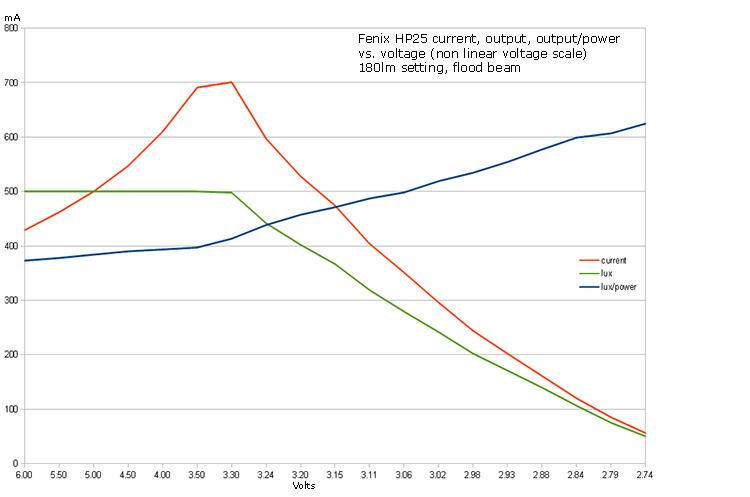
Decreasing the voltage further, the light kept running, though with understandably limited output as the voltage declined further, and somewhere between 2v2 and 2v1 it turned off.
At any point above the final turn-off voltage, output would increase back to previous levels if the voltage was increased.
Overall, the light behaved as would be expected from true linear regulation with the benefit of buck conversion for input voltages in the normal operating range.
When someone opens a unit up (I'm keeping mine intact for long-term testing) it would be interesting to see if the peak current observed (700mA) is the actual LED current on the '180lm' setting.
in line with having linear regulation, there was a different dropout voltage for the different outputs - while the 180lm setting dropped out of regulation at 3v37, the 90lm setting stayed on full output down to 3v09, and the 45lm setting to 2v99.
That does mean that even in the absence of any kind of low-battery indication, the user can get some idea if they're in the final stages of battery depletion if they cycle through the levels - if they do that and there isn't a difference between the 180lm and 90lm settings, then it's really time to change cells, or maybe switch to the 4lm level if that output is bearable and more runtime is needed.
Having the light run at full output with a 700mA draw at less than 0v85 per cell, and still pulling 100mA at 0.7V/cell would suggest that in real use, the mid-power runtime after it drops out of regulation might be rather short.
I'm running some tests for behaviour in the final stages of exhaustion with 4 and 3 cells at the moment - results in a few days.
If I was somewhere where I couldn't easily keep an eye on cell condition and above all I didn't want to be surprised, I might be tempted to try running off 3 cells and a dummy cell, which at the expense of losing 25% of the full-power runtime, might give give a much longer and smoother tail-off.
In conclusion, I do really like this light, and I have to give great credit to Fenix for producing a consumer-level twin beam light at a decent price.
I'd personally prefer to have a 4 levels for the spot beam as well as the flood, and power steppings changed to something like a constant x3, since that would open up the full beam-blending experience, something I really believe there's a significant potential market for.
Thinking of beam blending, a less-hard-edged spill on the spot (TIR optic?) would make blending rather more subtle - often with a blended beam one will be looking down at the ground, at the point where the outer spot and flood edges are hard to miss.
Also, to save myself from using the wrong terms, I'm going to avoid talking about low/med/high/turbo, since for some as-yet-unexplained reason for this light they mean different things for the two beams.
Operation is simple, with one pushbutton per LED, and using brief presses of the appropriate button to cycle indefinitely through the power levels, longer presses for off/on, and an extended press to engage SOS on the spot beam. Button pressure is a decent ~1kg
I do like having indefinite sequences with turn-off needing a more deliberate long action, though the need to hold a button down to turn on did seem a bit unintuitive.
Since the buttons are covered by a shield when the head unit is rotated back into its bracket, the long press to turn on doesn't seem necessary to prevent accidental activation, but I suppose most users will adjust to it in time.
The headstraps attach fairly easily, though they do take a little bit of manoeuvring under the split bars on the battery box.
The battery box itself looks reasonable, with gold-plated springs and contacts, though I haven't given it any immersion testing.
The user instruction sheet suggests the O-ring on the removable part is replaceable if it eventually wears out or gets damaged, but looking at it, I'm not sure how easy that would be. That said, given that all the contacts are accessible on the slide-out battery holder, they should be fairly easy to clean if dirty or to pre-emptively lubricate if the box was eventually found to leak.
Now, onto the beams.
I'm afraid beamshots will have to wait, but I will post some in the post below this one when they are done. To be honest, I'm not sure how useful they would be - white wall shots might emphasise things which are rather less obvious in actual use, while in-use shots showing significant things like transitions between beam areas might be tricky.
The flood beam is slightly centre-weighted, and does have some minor artifacts.
Looking at a white wall, it is, to a first approximation a couple of concentric circles, with the inner circle being about 3/5 the size of the outer one, and slightly brighter, though not hugely so.
The outer circle has a fairly hard cutoff, though on my unit there is also a slightly off-centre halo of much dimmer light outside the outer circle, shifted towards top left (on bottom right, the halo edge touches the main beam edge).
Rough luxmeter results might give some perspective in terms of variation across the beam.
I made some readings with the light and meter kept at constant distance, set up so that the beam centre gave a reading of 100, with the light being rotated to measure output in various parts of the beam.
In my light, with the beam centre at 100, the output across the inner circle varied between 95 and 110, tending to be slightly brighter towards the edge, so is effectively flat. In the outer circle it was mainly around 60-70, so not drastically darker.
I suppose the acid test for flood smoothness for me is reading, and I found reading with the HP25 absolutely great - I didn't notice any unevenness at all in the area of the beam I use to read, and even further out I had to look and know what I was looking for to really see anything.
In outdoor use, even walking along a fairly uniform-coloured road and actively looking for issues, the inner/outer circle boundary only seemed to be a rather faint slightly brighter line, so essentially flawless.
The faint halo outside the main edge of the flood which was visible on a white wall was not obvious, but on my light it was most present at the top and left of the beam where much of the time there is little to be lit, and a fair amount of it overlapped the area where the rims of my glasses interrupt vision, so wasn't really somewhere I was looking anyway.
The overall width of the flood was OK, with walking typically using the headset tilted down two or three clicks to properly light the area about to be stepped on with the head at a natural angle.
It's a distinctly tighter beam than my original Zebralight, and I'm not sure I'd want it to be any tighter, but than having it just-wide-enough does give advantages in terms of intensity.
The spot beam is quite tight, with an even circular hotspot and a much dimmer local halo visible on a white wall, but at realistic distances outside, the spot just seems to have a somewhat softened edge and no obvious halo.
There is a fairly even low spill extending out to a sharp cutoff at a circular edge only a little outside the edge of the flood beam's inner circle.
Outside the centre, the spill intensity is something like 1% of the central intensity, which may not sound like much, but it still measures as brighter than the flood beam when the flood is running at half the power output.
Outdoors, the spot does light distant objects well, though if looking at distant objects, the edge of the spill on the ground can still seem quite bright.
In a twin-beam light it's arguably unlikely that someone would be using the spot beam alone for non-spot duties like walking, but apart from the spill area being slightly narrow and hard-edged, the spot is quite usable for general movement.
As beams to use individually, I think both are decent, but I'm not sure they're the perfect ones to run simultaneously. In particular, the reflectored spot beam with a naturally hard edge to the spill is maybe not ideal for mixing with a flood since the edge of the spot's spill does give a significant two-level nature to the combined flood at most flood/spot blends. A spot which had less spill and particularly a softer outer edge to the spill could be blended rather more easily.
One of my long-time personal favourite beam blends is flood-plus-a-touch-of-spot, with the spot helping to significantly increase the reach of the flood without consuming meaningful extra power and without taking away from the flood nature of the beam.
Especially with a tight spot, that would involve a spot:flood output blend of the order of 10:1 or more, but given the close power stepping and the lack of a low output setting for the spot, that's not a blend that is really accessible on a HP25, since even maximum flood to minimum spot gives a beam with serious spot content.
Regarding power levels, as might be predicted from the figures, the subjective difference between the 180/90/45 lumen settings wasn't huge.
The 4lm flood was perfectly usable for walking with, though as might be expected, it was close to the lower limit for fully engaging colour vision, and the difference between it and the 45lm setting was quite noticeable in terms of colour quality as well as general brightness.
There was no visible PWM at any power setting with either eye movements or illuminating moving objects, and later testing (see below) points towards the existence of a 'pure' linear regulator.
Now, on to voltages and currents.
With 4xEneloops, I got the following current readings in mA, checking out one beam at a time.
| 4lm | 45lm | 90lm | 180lm | |
| flood | 7 | 89 | 213 | 525 |
| spot | 84 | 218 | 537 |
A swift check, measuring the current draw (in mA) from both 4 and 3 Eneloops with a luxmeter present showed no difference in output and slightly higher efficiency at the lower voltage with 3 cells. To get more information, I had to sidetrack a little to build a variable voltage PSU, having been without one for a while.
With the PSU, and setting the HP25 to 180lm output on the flood beam, it could be seen that the output of my unit was perfectly regulated down to an input voltage of 3v30, with efficiency rising slightly with decreasing voltage.
Below 3v3, the output declined roughly linearly until at 2v75 it was 10% of the initial level, essentially like an LED in direct drive, or direct drive with a little extra voltage drop.
In the graph below, the lux and lux/power figures are based on an arbitrary (though fixed) positioning of the HP25 and luxmeter, in order to show relative changes in output and efficiency.
To avoid having a large amount of essentially flat lines, the horizontal scale drops in 0.5V steps to the point where interesting things happen, and then in ~0.5V steps thereafter.

Decreasing the voltage further, the light kept running, though with understandably limited output as the voltage declined further, and somewhere between 2v2 and 2v1 it turned off.
At any point above the final turn-off voltage, output would increase back to previous levels if the voltage was increased.
Overall, the light behaved as would be expected from true linear regulation with the benefit of buck conversion for input voltages in the normal operating range.
When someone opens a unit up (I'm keeping mine intact for long-term testing) it would be interesting to see if the peak current observed (700mA) is the actual LED current on the '180lm' setting.
in line with having linear regulation, there was a different dropout voltage for the different outputs - while the 180lm setting dropped out of regulation at 3v37, the 90lm setting stayed on full output down to 3v09, and the 45lm setting to 2v99.
That does mean that even in the absence of any kind of low-battery indication, the user can get some idea if they're in the final stages of battery depletion if they cycle through the levels - if they do that and there isn't a difference between the 180lm and 90lm settings, then it's really time to change cells, or maybe switch to the 4lm level if that output is bearable and more runtime is needed.
Having the light run at full output with a 700mA draw at less than 0v85 per cell, and still pulling 100mA at 0.7V/cell would suggest that in real use, the mid-power runtime after it drops out of regulation might be rather short.
I'm running some tests for behaviour in the final stages of exhaustion with 4 and 3 cells at the moment - results in a few days.
If I was somewhere where I couldn't easily keep an eye on cell condition and above all I didn't want to be surprised, I might be tempted to try running off 3 cells and a dummy cell, which at the expense of losing 25% of the full-power runtime, might give give a much longer and smoother tail-off.
In conclusion, I do really like this light, and I have to give great credit to Fenix for producing a consumer-level twin beam light at a decent price.
I'd personally prefer to have a 4 levels for the spot beam as well as the flood, and power steppings changed to something like a constant x3, since that would open up the full beam-blending experience, something I really believe there's a significant potential market for.
Thinking of beam blending, a less-hard-edged spill on the spot (TIR optic?) would make blending rather more subtle - often with a blended beam one will be looking down at the ground, at the point where the outer spot and flood edges are hard to miss.


